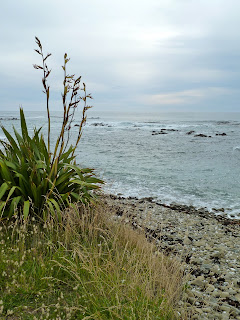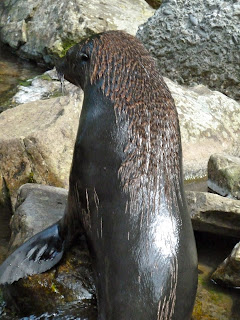When you have an intuitively good feeling about a place, it's easy to look around and see beautiful things. Colour was big in NZ.
On South Island there were wildflowers almost everywhere – by the roadside, on stream and river beds and banks, at the back of beaches. (Yellow has always been my favourite colour.) At times the sea was a most extraordinary light turquoise colour and the mountains a purple haze in the hot afternoon sun. I have never counted so many blue hues in a landscape.

These tall, purple-blue flowers were all over the place. They are Viper's Bugloss, or Blue Borage, which flowers from December to March. Blue Borage honey is particularly pure (there is a low risk of pesticide and chemical contamination) and has a delicate flavour with a herbal or fruity scent. It is not a cultivated plant: it grows wild in dry areas with poor soils. South Island is a primary source of Viper's Bugloss honey.
There seemed to be lots of different trees (from Oz): they were often clumped in close proximity, creating pleasing arboreal patchworks.
Related to Australian Melaleuca, the Manuka (above), or tea tree*, is a common shrub or small tree with whitish or pinkish flowers. It's well-known for its antibacterial properties and is also used in honey production.
New Zealand boasts its own tree ferns. These were in the Puhi Puhi valley near Hapuku.
Lone sentinels were a feature of the landscape, and included 'my tree', the subject of many photographs taken from Hapuku Lodge. One afternoon I got as close as I could to it, also in the Puhi Puhi valley.

The silver fern has become New Zealand's unofficial national symbol and the All Blacks' (and other teams' and organisations') logo. When we first arrived, we enthused about all impressive ferns in the hope that they were the one, but in fact none of them was. Rather like New Zealand's official national symbol, the Kiwi**, they are few and far between. Neither of these is a Silver Fern.
Flax is one of New Zealand's most distinctive native plants. It isn't related to flax as we Europeans know it but was given the same name by settlers since it produces similar long leaf fibres. The Maori have long used it for clothing, sandals, baskets, mats, cooking utensils, string and rope, animal traps, fishing nets and lines, sails and rigging, roofing, a host of medicinal purposes and as a sweetener (using the nectar).

…and fauna
Birds love flax flowers which makes them easier to photograph; the birds, that is. The Yellowhammer (below) was imported from Europe (where is it now in decline) in 1862 and quickly established itself throughout New Zealand's islands. Only the male has a bright yellow head, and the duller females are often mistaken for House Sparrows, of which there are many. The Sparrows look fatter and more robust than their European cousins.

The Tui (above) is a member of the honeyeater family and a real New Zealand character. It didn't seem to mind sharing its patch with Hapuku's guests, and provided an almost constant vocal presence. I noticed frequent twittering birdsong that reminded me of home, and at first I assumed it must be several birds. The Tui, however, has two voice boxes that enable it to produce a range of very different sounds, and even imitate humans, like a parrot.
Talking of which, Red-crowned Parakeets, or Kakariki, were being reared in an 'incubator' at Hapuku Lodge as part of a breeding programme. Endemic to New Zealand, the birds are seriously endangered because of habitat destruction and predation by invading mammals. The Lodge plans to release the parrots' offspring every autumn in the hope that they'll stick around and establish a resident colony in the Manuku grove beneath the tree houses. The Kakariki were curious and friendly and made soothing chuntering noises.
The Black-backed Gull, or Karoro, is a bit of a bruiser. It's a huge great thing (bigger than Brighton's monsters back home) and described as 'robust, intelligent, opportunistic and aggressive' (http://www.nzbirds.com).
The Red-billed Gull – a relative of Australia's Silver Gull – is gregarious and loves gravel beaches and rocky headlands so is at home here.
I had never seen an Albatross before. (Thanks to my friend for the picture above, and the whales below.) As our whale-watching boat scoured the ocean for spouts, these magnificant birds rose and swooped, never flapping but quietly gliding using their massive wingspan. I'm fairly confident this is a Buller's Albatross. We probably saw different varieties, and of Petrels. Most were impossible to ID without reference, and our minds were on other things at the time, namely Sperm Whales.
These creatures are year-round visitors to Kaikoura, but are by no means the only whales to frequent these teeming waters. Migrating Humpbacks, Southern Rights, Blue Whales and Pilot Whales also visit. Sperm Wales are the largest toothed animals and we were lucky enough to see those teeth. The whales usually spend about ten minutes on the surface breathing – they looked a bit like logs, I thought – before diving back down to the depths to feed again. One we saw, however, didn't flip his tail up and head down, and our guides thought he might be feeding just below the surface. A few minutes later, he reappeared, open-mouthed and brandishing an impressive row of bottom teeth.
Sperm whales are the squareheads of the ocean. As well as holding the largest brain ever known on earth, their massive head contains large quantities of what is called spermaceti; but the oily fluid is not sperm. Its function is not entirely understood but is believed to help the whale regulate its buoyancy when diving and resurfacing: it solidifies in the cold depths into a waxy substance. Sperm whales dive to about 1,000 metres after giant squid, and can hold their breath for about 90 minutes while doing so.
Whale watching vessels compare sightings to help each other predict where and when whales might surface next, and use underwater microphones to detect the whales' calls. We spent about two and a half hours on the water and saw three or four Sperm Whales in that time. Unfortunately we didn't see any Dusky Dolphins – they hang out further inshore. (You can swim with them on dolphin encounter tours organised from Kaikoura.) We did see a small shark, possibly a young Blue.

We did have several encounters with New Zealand Fur Seals (Kekeno in Maori). They can be seen all around the coast of South Island, but look carefully because sometimes they're barely distinguishable from rocks. We visited the seal colony at Ohau, a few kilometres north of Hapuku (start looking out for seals from Half Moon Bay onwards), and we also spotted them around the Kaikoura Peninsula. Both these sites are haul-out points. Seals look very awkward on land, but can move quite quickly. You should not approach to within 20 metres of one, and never place yourself between a seal and its escape route to the sea: they have sharp teeth and males are quite bulky.
Seals are extremely graceful movers in the water. They can dive for food for about ten minutes, and to a depth of up to 300 metres, but it's usually more like a couple of minutes at most. When they haul themselves out on to rocks there's a lot of jostling for position and squabbling. Youngsters keep out of the way of dominant males who seem to do a lot of posturing and showing off, but are seen off by protective females. The breeding season is November-December and pups are born from November to January. They're weaned by the following September. There were quite a few babies on the rocks at Ohau Point.


A short, easy walk inland from a large car park on the left of Highway 1 (travelling north) will get you to the Ohau waterfall. At the base is a plunge pool where young seals gather in winter to play. We weren't there at the right time of year, but a couple of young adults were making their way down the boulder-strewn creek to the sea. We were on the bank of the stream, and the seals clocked us, but they cautiously made their way past within less than a metre of where we were sitting, motionless. As if to reassure themselves, one looked back at the other and they touched noses. My friend caught this delightful moment on camera.
* So-called because Captain Cook used the leaves to make a tea-style drink
** Each of the five species of Kiwi live in isolated pockets, four on South Island and one on North. All are endangered as a result of deforestation and predation by invasive mammals such as stoats, ferrets, cats and dogs



This comment has been removed by a blog administrator.
ReplyDeleteThis comment has been removed by a blog administrator.
ReplyDelete